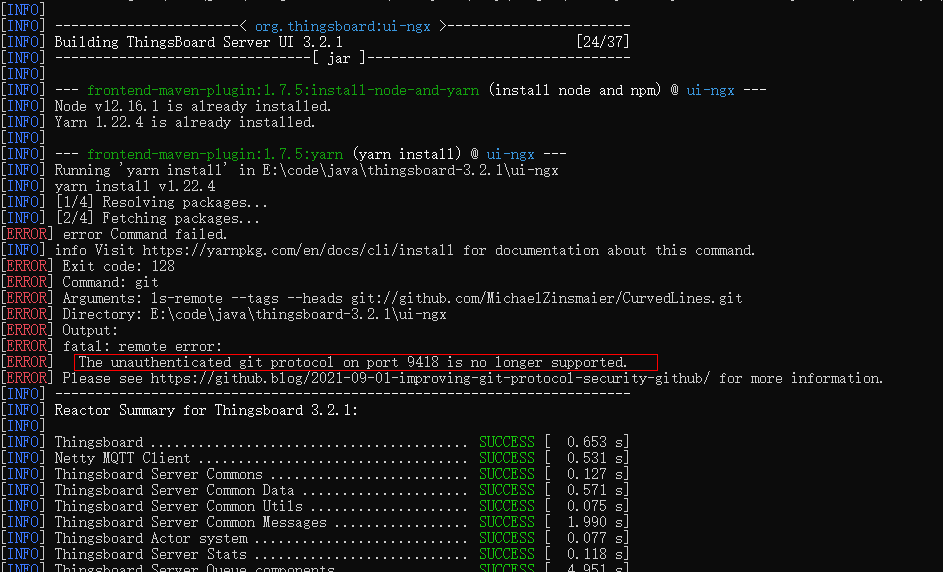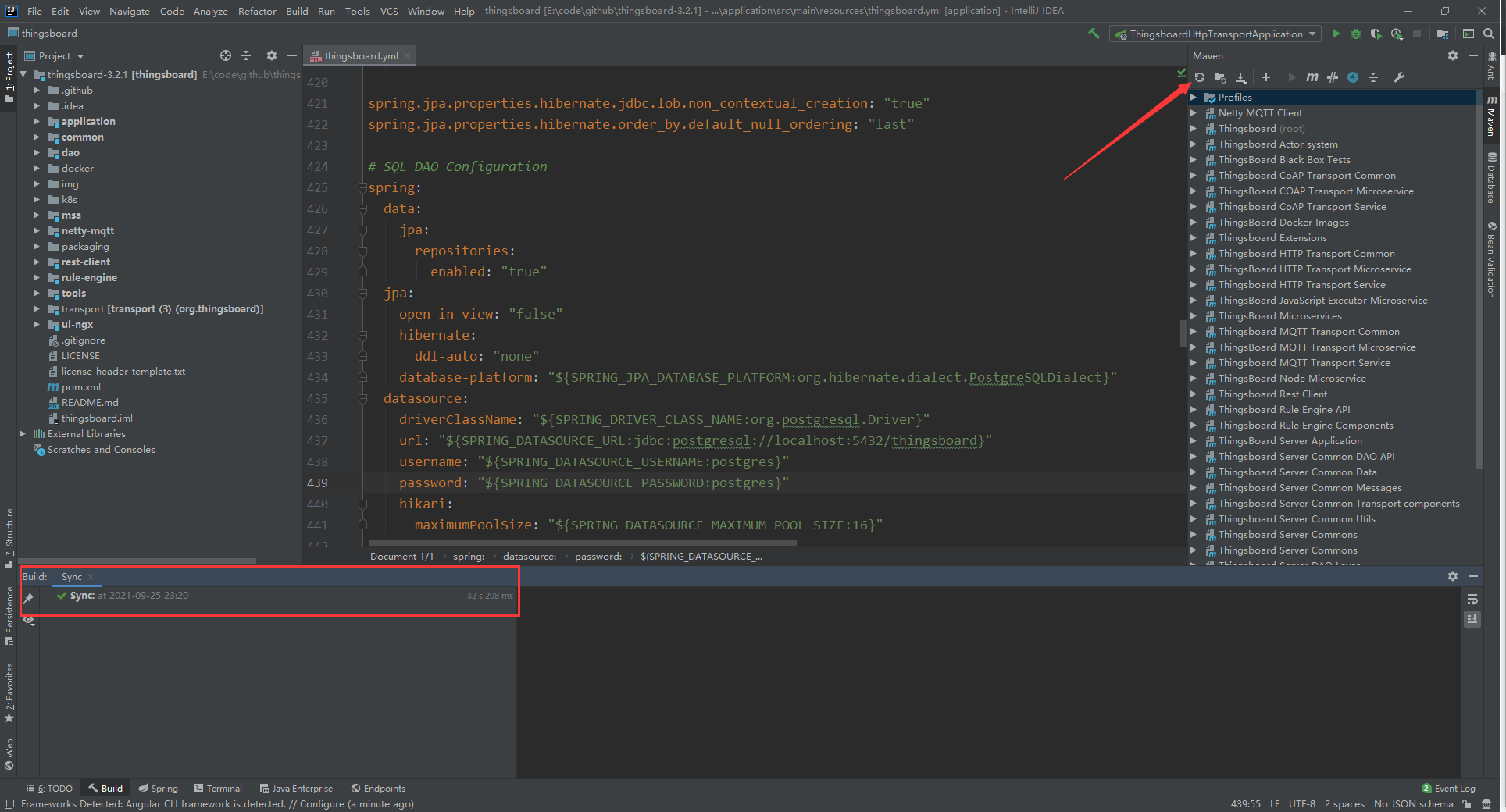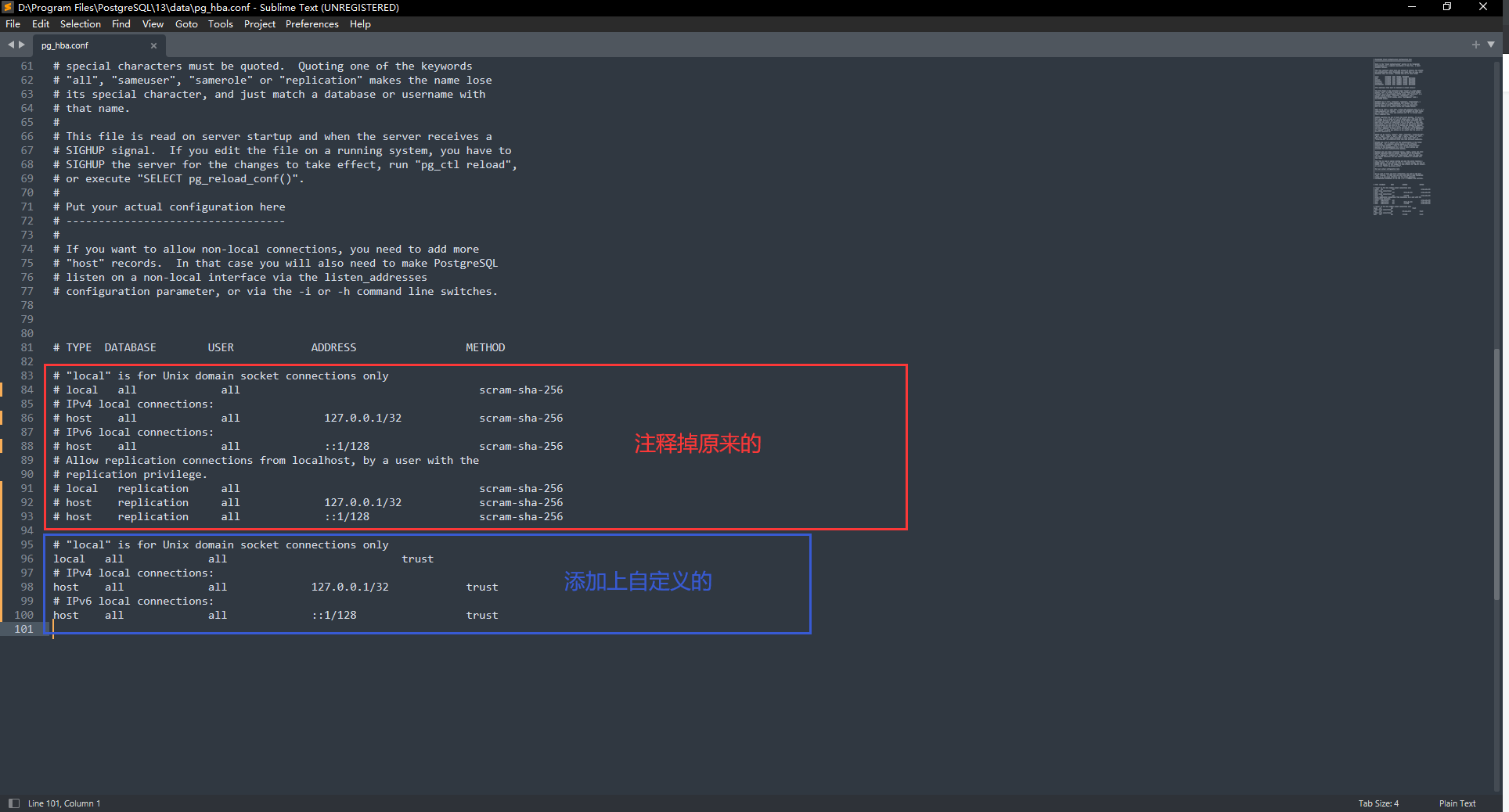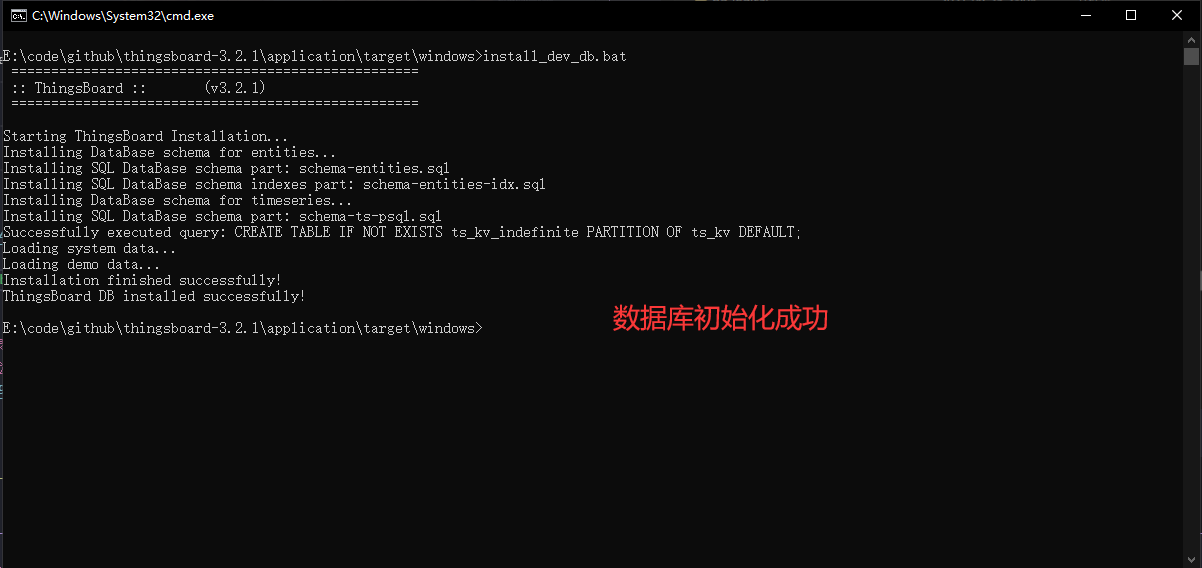# 前言
深夜踩坑真艰难,但获得的成就感也是最开心的~
# 从 GitHub 上 Clone 下源码后运行 Mavan 报错
如果运行 mvn clean install -DskipTests --settings D:\scoop\apps\maven\current\conf\thingsboardSettings.xml 命令后编译报错,最大的可能就是 jdk 的版本和仓库的版本不符,目前仓库最新的代码(thingsboard-3.3.1)用的 jdk 是 jdk11,而我电脑上安装的是 jdk8,所以这肯定就编译不过了。解决办法就是去 GitHub Release 找到 ThingsBoard 3.2.1 Release 下载,注意选择源码版本下载,如下图。3.2.1 版本的 thingsboard 是用的 jdk8,然后在运行 mvn 命令就不会报编译错误了。

thingsboardSettings.xml 文件内容放到文章附录,需要的自取。注意将文件中的 <localRepository>D:\RepMaven</localRepository> 改成自己的路径
# 报错 The unauthenticated git protocol on port 9418 is no longer supported.
报错如下图

哎,这个就是由于最新版本的 git 提升安全性加入了新特性(2022.1.11)导致的
解决办法就是在 .gitconfig 文件中加入如下语句
[url "https://"] | |
insteadOf = ssh:// | |
[url "https://"] | |
insteadOf = git:// |
然后重新进行编译即可~~
参考链接:The unauthenticated git protocol on port 9418 is no longer supported.
# Cannot resolve com.sun:tools:1.4.2

这个问题真是太坑了,因为我的 jdk8 是通过 scoop 安装的,而这个工具安装的 jdk8 没有配置 CLASSPATH 环境变量,导致找不到 com.sun:tools
解决办法就是在环境变量里配置一下 CLASSPATH 为 .;%JAVA_HOME%\lib\dt.jar;%JAVA_HOME%\lib\tools.jar ,如下图。

配置完成后再在 IDEA 里打开项目,点击侧边栏 Maven 下方的刷新按钮,刷新完成后项目就不再报错啦~

# org.postgresql.util.PSQLException: 不支援 10 验证类型。请核对您已经组态 pg_hba.conf 文件包含客户端的 IP 位址或网路区段,以及驱动程序所支援的验证架构模式已被支援
运行数据库初始化脚本 install_dev_db.bat 报错。感谢这位老哥的帖子给出了解决方案
解决办法:找到 pgsql 的安装目录下的 pg_hba.conf 文件,如下图

用文本编辑器打开后做如下修改
# "local" is for Unix domain socket connections only
local all all trust
# IPv4 local connections:
host all all 127.0.0.1/32 trust
# IPv6 local connections:
host all all ::1/128 trust

修改完成后,再次运行 install_dev_db.bat 脚本就不会报错啦~

# 参考链接
- ThingsBoard 开源物联网平台学习记录
- pgsql 在连接的时候报:不支援 10 验证类型。请核对您已经组态。。。
- Thingsboard 入门教程:本地环境搭建和源码编译安装,献给 thingsboard 编译失败的同学,教程不断优化
# 附录
<?xml version="1.0" encoding="UTF-8"?> | |
<!-- | |
Licensed to the Apache Software Foundation (ASF) under one | |
or more contributor license agreements. See the NOTICE file | |
distributed with this work for additional information | |
regarding copyright ownership. The ASF licenses this file | |
to you under the Apache License, Version 2.0 (the | |
"License"); you may not use this file except in compliance | |
with the License. You may obtain a copy of the License at | |
http://www.apache.org/licenses/LICENSE-2.0 | |
Unless required by applicable law or agreed to in writing, | |
software distributed under the License is distributed on an | |
"AS IS" BASIS, WITHOUT WARRANTIES OR CONDITIONS OF ANY | |
KIND, either express or implied. See the License for the | |
specific language governing permissions and limitations | |
under the License. | |
--> | |
<!-- | |
| This is the configuration file for Maven. It can be specified at two levels: | |
| | |
| 1. User Level. This settings.xml file provides configuration for a single user, | |
| and is normally provided in ${user.home}/.m2/settings.xml. | |
| | |
| NOTE: This location can be overridden with the CLI option: | |
| | |
| -s /path/to/user/settings.xml | |
| | |
| 2. Global Level. This settings.xml file provides configuration for all Maven | |
| users on a machine (assuming they're all using the same Maven | |
| installation). It's normally provided in | |
| ${maven.conf}/settings.xml. | |
| | |
| NOTE: This location can be overridden with the CLI option: | |
| | |
| -gs /path/to/global/settings.xml | |
| | |
| The sections in this sample file are intended to give you a running start at | |
| getting the most out of your Maven installation. Where appropriate, the default | |
| values (values used when the setting is not specified) are provided. | |
| | |
|--> | |
<settings xmlns="http://maven.apache.org/SETTINGS/1.0.0" | |
xmlns:xsi="http://www.w3.org/2001/XMLSchema-instance" | |
xsi:schemaLocation="http://maven.apache.org/SETTINGS/1.0.0 http://maven.apache.org/xsd/settings-1.0.0.xsd"> | |
<!-- localRepository | |
| The path to the local repository maven will use to store artifacts. | |
| | |
| Default: ${user.home}/.m2/repository | |
<localRepository>/path/to/local/repo</localRepository> | |
--> | |
<localRepository>D:\RepMaven</localRepository> | |
<!-- interactiveMode | |
| This will determine whether maven prompts you when it needs input. If set to false, | |
| maven will use a sensible default value, perhaps based on some other setting, for | |
| the parameter in question. | |
| | |
| Default: true | |
<interactiveMode>true</interactiveMode> | |
--> | |
<!-- offline | |
| Determines whether maven should attempt to connect to the network when executing a build. | |
| This will have an effect on artifact downloads, artifact deployment, and others. | |
| | |
| Default: false | |
<offline>false</offline> | |
--> | |
<!-- pluginGroups | |
| This is a list of additional group identifiers that will be searched when resolving plugins by their prefix, i.e. | |
| when invoking a command line like "mvn prefix:goal". Maven will automatically add the group identifiers | |
| "org.apache.maven.plugins" and "org.codehaus.mojo" if these are not already contained in the list. | |
|--> | |
<pluginGroups> | |
<!-- pluginGroup | |
| Specifies a further group identifier to use for plugin lookup. | |
<pluginGroup>com.your.plugins</pluginGroup> | |
--> | |
</pluginGroups> | |
<!-- proxies | |
| This is a list of proxies which can be used on this machine to connect to the network. | |
| Unless otherwise specified (by system property or command-line switch), the first proxy | |
| specification in this list marked as active will be used. | |
|--> | |
<proxies> | |
<!-- proxy | |
| Specification for one proxy, to be used in connecting to the network. | |
| | |
<proxy> | |
<id>optional</id> | |
<active>true</active> | |
<protocol>http</protocol> | |
<username>proxyuser</username> | |
<password>proxypass</password> | |
<host>proxy.host.net</host> | |
<port>80</port> | |
<nonProxyHosts>local.net|some.host.com</nonProxyHosts> | |
</proxy> | |
--> | |
</proxies> | |
<!-- servers | |
| This is a list of authentication profiles, keyed by the server-id used within the system. | |
| Authentication profiles can be used whenever maven must make a connection to a remote server. | |
|--> | |
<servers> | |
<!-- server | |
| Specifies the authentication information to use when connecting to a particular server, identified by | |
| a unique name within the system (referred to by the 'id' attribute below). | |
| | |
| NOTE: You should either specify username/password OR privateKey/passphrase, since these pairings are | |
| used together. | |
| | |
<server> | |
<id>deploymentRepo</id> | |
<username>repouser</username> | |
<password>repopwd</password> | |
</server> | |
--> | |
<!-- Another sample, using keys to authenticate. | |
<server> | |
<id>siteServer</id> | |
<privateKey>/path/to/private/key</privateKey> | |
<passphrase>optional; leave empty if not used.</passphrase> | |
</server> | |
--> | |
</servers> | |
<!-- mirrors | |
| This is a list of mirrors to be used in downloading artifacts from remote repositories. | |
| | |
| It works like this: a POM may declare a repository to use in resolving certain artifacts. | |
| However, this repository may have problems with heavy traffic at times, so people have mirrored | |
| it to several places. | |
| | |
| That repository definition will have a unique id, so we can create a mirror reference for that | |
| repository, to be used as an alternate download site. The mirror site will be the preferred | |
| server for that repository. | |
|--> | |
<mirrors> | |
<!-- mirror | |
| Specifies a repository mirror site to use instead of a given repository. The repository that | |
| this mirror serves has an ID that matches the mirrorOf element of this mirror. IDs are used | |
| for inheritance and direct lookup purposes, and must be unique across the set of mirrors. | |
| | |
<mirror> | |
<id>mirrorId</id> | |
<mirrorOf>repositoryId</mirrorOf> | |
<name>Human Readable Name for this Mirror.</name> | |
<url>http://my.repository.com/repo/path</url> | |
</mirror> | |
--> | |
<mirror> | |
<id>nexus-public-snapshots</id> | |
<mirrorOf>public-snapshots</mirrorOf> | |
<url>http://maven.aliyun.com/nexus/content/repositories/snapshots/</url> | |
</mirror> | |
<mirror> | |
<id>nexus</id> | |
<name>internal nexus repository</name> | |
<url>https://repo.maven.apache.org/maven2</url> | |
<mirrorOf>central</mirrorOf> | |
</mirror> | |
<mirror> | |
<id>maven-central</id> | |
<name>central</name> | |
<url>https://repo1.maven.org/maven2/</url> | |
<mirrorOf>central</mirrorOf> | |
</mirror> | |
<mirror> | |
<id>uk</id> | |
<mirrorOf>central</mirrorOf> | |
<name>Human Readable Name for this Mirror.</name> | |
<url>http://uk.maven.org/maven2/</url> | |
</mirror> | |
<mirror> | |
<id>CN</id> | |
<name>OSChina Central</name> | |
<url>http://maven.oschina.net/content/groups/public/</url> | |
<mirrorOf>central</mirrorOf> | |
</mirror> | |
</mirrors> | |
<!-- profiles | |
| This is a list of profiles which can be activated in a variety of ways, and which can modify | |
| the build process. Profiles provided in the settings.xml are intended to provide local machine- | |
| specific paths and repository locations which allow the build to work in the local environment. | |
| | |
| For example, if you have an integration testing plugin - like cactus - that needs to know where | |
| your Tomcat instance is installed, you can provide a variable here such that the variable is | |
| dereferenced during the build process to configure the cactus plugin. | |
| | |
| As noted above, profiles can be activated in a variety of ways. One way - the activeProfiles | |
| section of this document (settings.xml) - will be discussed later. Another way essentially | |
| relies on the detection of a system property, either matching a particular value for the property, | |
| or merely testing its existence. Profiles can also be activated by JDK version prefix, where a | |
| value of '1.4' might activate a profile when the build is executed on a JDK version of '1.4.2_07'. | |
| Finally, the list of active profiles can be specified directly from the command line. | |
| | |
| NOTE: For profiles defined in the settings.xml, you are restricted to specifying only artifact | |
| repositories, plugin repositories, and free-form properties to be used as configuration | |
| variables for plugins in the POM. | |
| | |
|--> | |
<profiles> | |
<!-- profile | |
| Specifies a set of introductions to the build process, to be activated using one or more of the | |
| mechanisms described above. For inheritance purposes, and to activate profiles via <activatedProfiles/> | |
| or the command line, profiles have to have an ID that is unique. | |
| | |
| An encouraged best practice for profile identification is to use a consistent naming convention | |
| for profiles, such as 'env-dev', 'env-test', 'env-production', 'user-jdcasey', 'user-brett', etc. | |
| This will make it more intuitive to understand what the set of introduced profiles is attempting | |
| to accomplish, particularly when you only have a list of profile id's for debug. | |
| | |
| This profile example uses the JDK version to trigger activation, and provides a JDK-specific repo. | |
<profile> | |
<id>jdk-1.4</id> | |
<activation> | |
<jdk>1.4</jdk> | |
</activation> | |
<repositories> | |
<repository> | |
<id>jdk14</id> | |
<name>Repository for JDK 1.4 builds</name> | |
<url>http://www.myhost.com/maven/jdk14</url> | |
<layout>default</layout> | |
<snapshotPolicy>always</snapshotPolicy> | |
</repository> | |
</repositories> | |
</profile> | |
--> | |
<!-- | |
| Here is another profile, activated by the system property 'target-env' with a value of 'dev', | |
| which provides a specific path to the Tomcat instance. To use this, your plugin configuration | |
| might hypothetically look like: | |
| | |
| ... | |
| <plugin> | |
| <groupId>org.myco.myplugins</groupId> | |
| <artifactId>myplugin</artifactId> | |
| | |
| <configuration> | |
| <tomcatLocation>${tomcatPath}</tomcatLocation> | |
| </configuration> | |
| </plugin> | |
| ... | |
| | |
| NOTE: If you just wanted to inject this configuration whenever someone set 'target-env' to | |
| anything, you could just leave off the <value/> inside the activation-property. | |
| | |
<profile> | |
<id>env-dev</id> | |
<activation> | |
<property> | |
<name>target-env</name> | |
<value>dev</value> | |
</property> | |
</activation> | |
<properties> | |
<tomcatPath>/path/to/tomcat/instance</tomcatPath> | |
</properties> | |
</profile> | |
--> | |
</profiles> | |
<!-- activeProfiles | |
| List of profiles that are active for all builds. | |
| | |
<activeProfiles> | |
<activeProfile>alwaysActiveProfile</activeProfile> | |
<activeProfile>anotherAlwaysActiveProfile</activeProfile> | |
</activeProfiles> | |
--> | |
</settings> |